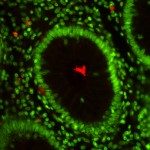Lien vers Pubmed [PMID] – 9380033
Mol. Pharmacol. 1997 Oct;52(4):692-700
We established previously that lipopolysaccharide (LPS) can induce the expression of LPS-binding sites on bone marrow cells (BMC). We now report that staurosporine (STP), a glycosylated indolocarbazole alkaloid with potent inhibitory activity for various protein kinases, can induce the same effect. With both agents, the newly expressed LPS receptor was found to be CD14. The STP-induced effect was independent of its protein kinase inhibitory activity because several other protein kinase inhibitors, such as the indolocarbazole K-252a, the bisindolylmaleimide RO-31-8220, the perylenequinone calphostin C, and the isoquinolinesulfonamide H7, did not induce CD14 expression. The observation that the STP analog K-252a with an identical polyaromatic aglycon moiety was inactive yet the analog UCN-01 with an identical glycoside ring was active suggests that the induction of CD14 expression is triggered by the sugar moiety of STP. Three lines of evidence show that the mechanism of CD14 expression induced by STP differs from that induced by LPS: (i) unlike LPS, STP can stimulate BMC from LPS-unresponsive C3H/HeJ mice, (ii) LPS and STP effects are additive at a saturating dose of LPS, and (iii) the protein kinase inhibitor K-252a inhibits the LPS-induced but not STP-induced stimulation. Therefore, our findings show that both a protein kinase-dependent (LPS-induced) and a protein kinase-independent (STP-induced) mechanism can lead to the expression of the LPS receptor CD14 on BMC. We also found that the STP-induced stimulation of BMC is modulated by cyclosporin A, vinblastine, and verapamil. This observation may suggest that the inducible effect of STP could be initiated by its interaction with P-glycoprotein, a membrane pump with drug efflux function that plays a critical role in the multidrug resistance of cancer cells.

